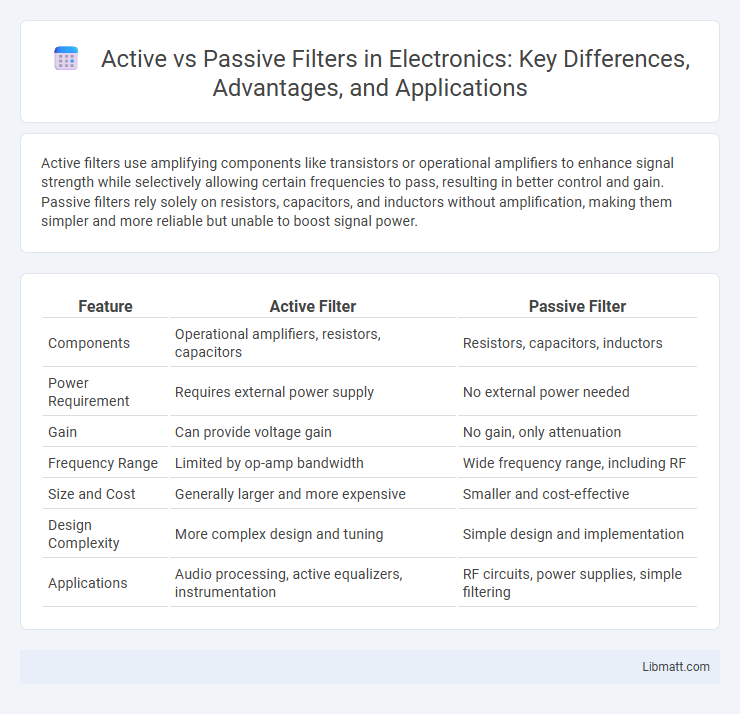Active filters use amplifying components like transistors or operational amplifiers to enhance signal strength while selectively allowing certain frequencies to pass, resulting in better control and gain. Passive filters rely solely on resistors, capacitors, and inductors without amplification, making them simpler and more reliable but unable to boost signal power.
Table of Comparison
| Feature | Active Filter | Passive Filter |
|---|---|---|
| Components | Operational amplifiers, resistors, capacitors | Resistors, capacitors, inductors |
| Power Requirement | Requires external power supply | No external power needed |
| Gain | Can provide voltage gain | No gain, only attenuation |
| Frequency Range | Limited by op-amp bandwidth | Wide frequency range, including RF |
| Size and Cost | Generally larger and more expensive | Smaller and cost-effective |
| Design Complexity | More complex design and tuning | Simple design and implementation |
| Applications | Audio processing, active equalizers, instrumentation | RF circuits, power supplies, simple filtering |
Introduction to Filters
Filters control signal frequencies, selectively allowing certain ranges to pass while attenuating others. Active filters use amplifying components like operational amplifiers to enhance signal strength, offering better performance and flexibility than passive filters, which rely solely on passive components such as resistors, capacitors, and inductors. Understanding the difference between active and passive filters is essential for designing circuits tailored to your signal processing needs.
Overview of Active and Passive Filters
Active filters use powered components like operational amplifiers, transistors, or ICs alongside resistors and capacitors to amplify and filter signals, offering improved performance such as gain control and better frequency response. Passive filters rely solely on passive components--resistors, capacitors, and inductors--without requiring an external power source, making them simpler but less flexible and less capable of amplification. Your choice between active and passive filters depends on the specific signal filtering needs, including frequency range, power consumption, and complexity.
Key Differences Between Active and Passive Filters
Active filters use amplifying components like operational amplifiers, transistors, or ICs to increase signal strength, while passive filters rely solely on resistors, capacitors, and inductors without gain. Active filters provide better control over gain, frequency response, and can achieve sharper cutoff characteristics, whereas passive filters have no power supply requirement and are simpler with inherent signal attenuation. The frequency range of active filters is typically broader, but passive filters are preferred for high-frequency applications due to lower noise and better linearity.
Components Used in Active and Passive Filters
Active filters use operational amplifiers along with resistors and capacitors to amplify signals and achieve desired frequency responses, enabling better control over gain and bandwidth. Passive filters rely solely on resistors, inductors, and capacitors without amplification, which limits their performance in applications requiring signal boost and precise tuning. Understanding these component differences helps you select the appropriate filter type for your electronic circuit design.
Frequency Response Comparison
Active filters utilize amplifying components like operational amplifiers, enabling precise control over gain and sharper frequency response characteristics compared to passive filters. Passive filters, composed of resistors, capacitors, and inductors, exhibit frequency response limitations due to inherent component losses and lack of signal gain, resulting in less steep roll-off rates. Consequently, active filters provide improved selectivity and adjustable bandwidth in applications requiring tailored frequency response.
Advantages of Active Filters
Active filters provide amplification capabilities, allowing them to enhance signal strength without the need for additional components like inductors, which can be bulky and expensive. They offer greater design flexibility with adjustable gain and precise control over cutoff frequencies, making them ideal for audio and communication systems. The integration of operational amplifiers in active filters results in higher input impedance and lower output impedance, reducing signal loss and improving performance.
Advantages of Passive Filters
Passive filters offer advantages such as simplicity, reliability, and no need for an external power source, making them ideal for durability and low maintenance. Their design allows for easy implementation in high-frequency applications due to minimal noise generation. You benefit from cost-effective components that provide stable performance without active device limitations.
Limitations of Active and Passive Filters
Active filters face limitations such as limited power handling capabilities and potential distortion at high frequencies due to the active components like operational amplifiers. Passive filters are constrained by their inability to provide voltage gain and can suffer from signal attenuation, especially in low-frequency applications. Both filter types may encounter issues with component tolerances affecting precision and stability in filter performance.
Applications of Active and Passive Filters
Active filters are commonly used in audio processing, signal conditioning, and communication systems because they offer amplification and greater flexibility in tuning frequency responses. Passive filters find applications in RF circuits, power supplies, and hardware protection due to their simplicity, reliability, and no power requirement. Your choice between active and passive filters depends on factors like signal levels, frequency range, and power availability in the specific application.
Choosing the Right Filter for Your Circuit
Selecting the right filter for your circuit depends on factors such as signal frequency, power requirements, and component complexity. Active filters use operational amplifiers to provide gain and precise frequency response without inductors, ideal for low-frequency or low-power applications. Passive filters, composed of resistors, capacitors, and inductors, offer simplicity and reliability for high-frequency signals but lack amplification and can introduce insertion loss.
Active vs Passive Filter Infographic

 libmatt.com
libmatt.com